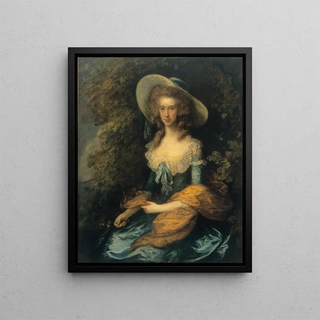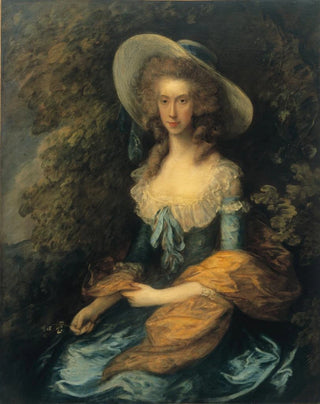Art print | Portrait of Miss Evans - Thomas Gainsborough


View from behind

Frame (optional)
The "Portrait of Miss Evans" by Thomas Gainsborough is an iconic artwork that embodies the refinement and elegance of 18th-century England. Created in 1758, this painting depicts a young woman of striking beauty, whose gaze and posture reflect innate sophistication. Gainsborough, an undisputed master of portraiture, manages to capture not only the physical appearance of his subject but also her essence, character, and the delicacy of her soul. The piece stands out for its subtle use of light and color, inviting viewers to immerse themselves in a world where beauty and grace reign supreme.
Style and uniqueness of the work
Gainsborough's style is often characterized by his fluid painting technique and light brushstrokes, which impart a sense of movement and vitality to his subjects. In the "Portrait of Miss Evans," the artist employs a palette of soft colors, ranging from pastel tones to deeper shades, creating an atmosphere that is both intimate and refined. The young woman's dress, richly adorned and carefully draped, is a true masterpiece in itself, showcasing Gainsborough's talent for depicting textures and details. The composition is thoughtfully balanced, highlighting Miss Evans' delicate face while incorporating elements of her environment that add depth to the piece. This portrait is a perfect example of how Gainsborough manages to blend realism and idealization, producing an image that transcends mere visual representation to evoke lasting emotions.
The artist and his influence
Thomas Gainsborough, born in 1727, is one of the most influential painters of his time, and his impact on British art is undeniable. Trained in outdoor painting and portraiture, he successfully merged Baroque influences with Rococo, developing a style that is uniquely his own. His ability to depict nature and human figures with such finesse has inspired many artists, both contemporaries and successors. Gainsborough also played a key role in the evolution of portrait painting, moving away from

Matte finish

View from behind

Frame (optional)
The "Portrait of Miss Evans" by Thomas Gainsborough is an iconic artwork that embodies the refinement and elegance of 18th-century England. Created in 1758, this painting depicts a young woman of striking beauty, whose gaze and posture reflect innate sophistication. Gainsborough, an undisputed master of portraiture, manages to capture not only the physical appearance of his subject but also her essence, character, and the delicacy of her soul. The piece stands out for its subtle use of light and color, inviting viewers to immerse themselves in a world where beauty and grace reign supreme.
Style and uniqueness of the work
Gainsborough's style is often characterized by his fluid painting technique and light brushstrokes, which impart a sense of movement and vitality to his subjects. In the "Portrait of Miss Evans," the artist employs a palette of soft colors, ranging from pastel tones to deeper shades, creating an atmosphere that is both intimate and refined. The young woman's dress, richly adorned and carefully draped, is a true masterpiece in itself, showcasing Gainsborough's talent for depicting textures and details. The composition is thoughtfully balanced, highlighting Miss Evans' delicate face while incorporating elements of her environment that add depth to the piece. This portrait is a perfect example of how Gainsborough manages to blend realism and idealization, producing an image that transcends mere visual representation to evoke lasting emotions.
The artist and his influence
Thomas Gainsborough, born in 1727, is one of the most influential painters of his time, and his impact on British art is undeniable. Trained in outdoor painting and portraiture, he successfully merged Baroque influences with Rococo, developing a style that is uniquely his own. His ability to depict nature and human figures with such finesse has inspired many artists, both contemporaries and successors. Gainsborough also played a key role in the evolution of portrait painting, moving away from






